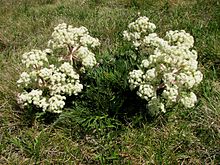| Aciphylla glacialis | |
|---|---|
 | |
| In flower at Mount Hotham, Victoria | |
| Scientific classification | |
| Kingdom: | Plantae |
| Clade: | Tracheophytes |
| Clade: | Angiosperms |
| Clade: | Eudicots |
| Clade: | Asterids |
| Order: | Apiales |
| Family: | Apiaceae |
| Genus: | Aciphylla |
| Species: | A. glacialis |
| Binomial name | |
| Aciphylla glacialis | |
| Synonyms | |
Gingidium glacialeF.Muell. | |
Aciphylla glacialis, commonly known as snow aciphyll or mountain celery, is a tufted perennial herb that is found in mountainous regions of south-eastern Australia. [1]